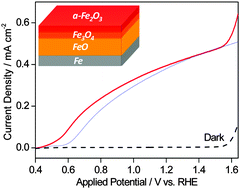A hematite photoanode with gradient structure shows an unprecedentedly low onset potential for photoelectrochemical water oxidation†
Abstract
Ultra-high onset potential hinders the application of hematite for photoelectrochemical (PEC) water splitting. Herein, a hematite photoanode with an unprecedentedly low onset potential of 0.50 V vs. the reversible hydrogen electrode for PEC water oxidation is reported. The drastically reduced onset potential is mainly ascribed to the passivation of the hematite surface states and the gradient structure made by H2–O2 flame at high temperature.


 Please wait while we load your content...
Please wait while we load your content...